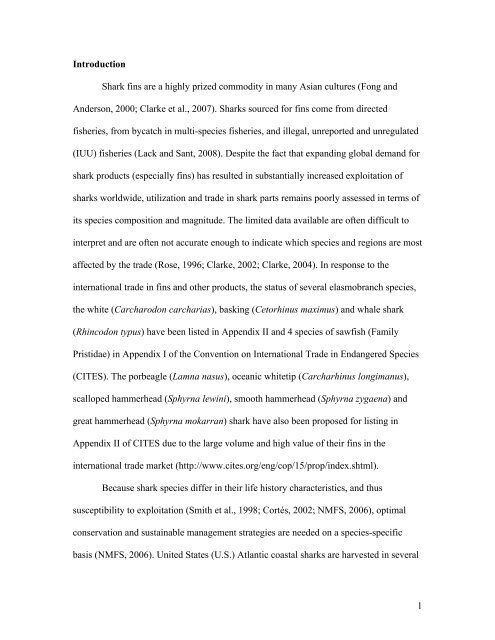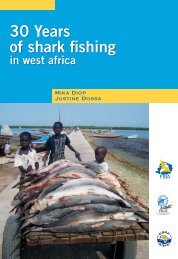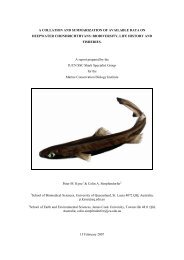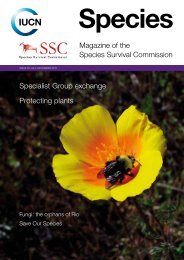Abercrombie et al_Fi..
Abercrombie et al_Fi..
Abercrombie et al_Fi..
Create successful ePaper yourself
Turn your PDF publications into a flip-book with our unique Google optimized e-Paper software.
Introduction<br />
Shark fins are a highly prized commodity in many Asian cultures (Fong and<br />
Anderson, 2000; Clarke <strong>et</strong> <strong>al</strong>., 2007). Sharks sourced for fins come from directed<br />
fisheries, from bycatch in multi-species fisheries, and illeg<strong>al</strong>, unreported and unregulated<br />
(IUU) fisheries (Lack and Sant, 2008). Despite the fact that expanding glob<strong>al</strong> demand for<br />
shark products (especi<strong>al</strong>ly fins) has resulted in substanti<strong>al</strong>ly increased exploitation of<br />
sharks worldwide, utilization and trade in shark parts remains poorly assessed in terms of<br />
its species composition and magnitude. The limited data available are often difficult to<br />
interpr<strong>et</strong> and are often not accurate enough to indicate which species and regions are most<br />
affected by the trade (Rose, 1996; Clarke, 2002; Clarke, 2004). In response to the<br />
internation<strong>al</strong> trade in fins and other products, the status of sever<strong>al</strong> elasmobranch species,<br />
the white (Carcharodon carcharias), basking (C<strong>et</strong>orhinus maximus) and wh<strong>al</strong>e shark<br />
(Rhincodon typus) have been listed in Appendix II and 4 species of sawfish (Family<br />
Pristidae) in Appendix I of the Convention on Internation<strong>al</strong> Trade in Endangered Species<br />
(CITES). The porbeagle (Lamna nasus), oceanic whit<strong>et</strong>ip (Carcharhinus longimanus),<br />
sc<strong>al</strong>loped hammerhead (Sphyrna lewini), smooth hammerhead (Sphyrna zygaena) and<br />
great hammerhead (Sphyrna mokarran) shark have <strong>al</strong>so been proposed for listing in<br />
Appendix II of CITES due to the large volume and high v<strong>al</strong>ue of their fins in the<br />
internation<strong>al</strong> trade mark<strong>et</strong> (http://www.cites.org/eng/cop/15/prop/index.shtml).<br />
Because shark species differ in their life history characteristics, and thus<br />
susceptibility to exploitation (Smith <strong>et</strong> <strong>al</strong>., 1998; Cortés, 2002; NMFS, 2006), optim<strong>al</strong><br />
conservation and sustainable management strategies are needed on a species-specific<br />
basis (NMFS, 2006). United States (U.S.) Atlantic coast<strong>al</strong> sharks are harvested in sever<strong>al</strong><br />
1
















